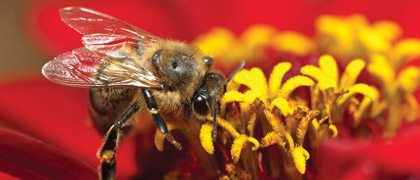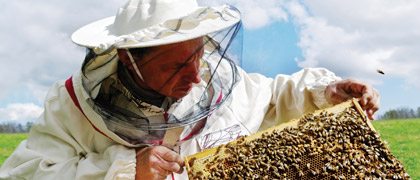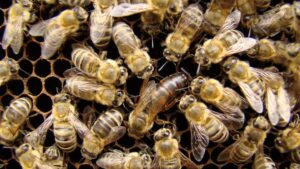Commercial beekeepers across North America have been witnessing losses of honey bee colonies for several years now. While neonicotinoid-based pesticides have taken much of the blame publicly, honey bee experts caution that the relationship between crop protection products and bee health is extremely complicated and research is still in its infancy.
As colony losses peak, industry players are coming together to conduct research in hopes of broadening knowledge of the intricate relationship between crop protectants and honey bee health.
In recent years, the neonicotinoid class of chemicals has been publicly associated with honey bee health declines. However, Dennis vanEngelsdorp, an assistant research scientist at the University of Maryland, says a new research study titled Crop Pollination Exposes Honey Bees to Pesticides Which Alters Their Susceptibility to the Gut Pathogen Nosema Ceranae, published in the scientific journal PLOS ONE, indicates it is the interaction of multiple pesticides that is affecting bee health in addition to many other external factors.
|
QUICK FACT |
Bill Hairston, director of product development for Bayer CropScience’s SeedGrowth Division, agrees that multiple factors are involved. “Most scientists, including the Environmental Protection Agency and United States Department of Agriculture experts, are in agreement that bee health is associated with multiple stressors,” Hairston says. “Large-scale field studies have shown that colony decline correlates strongly with the presence of parasitic mites and diseases, but not with agricultural pesticides, including neonicotinoids. One of the most important factors is the Varroa mite, a parasite that has been clearly linked to colony decline. Other important factors include poor nutrition, loss of habitat and the need to optimize hive management practices.”
In the vanEnglesdorp study, researchers collected pollen as bees returned to the hive after pollinating crops. “We collected the pollen pellets and analyzed those for pesticides, and we found an awful lot of pesticides. In fact, the average amount was nine different pesticides and up to 21 different pesticides from one pollen sample,” says vanEngelsdorp.
The most common pesticides researchers found were those beekeepers apply themselves to control Varroa mites. After miticides, chlorothalonil, a commonly-used fungicide, was the next major product found. “We weren’t expecting to find fungicides to be a major driver, but we did. So there is quite a bit of work that needs to be done there to determine what is going on. It could be doing something to the bees’ stomach linings or it could be affecting their immune systems.” says vanEngelsdorp.
The study also found that neonicotinoids, miticides and chlorothalonil are not the only products being found in pollen samples. “They are all a part of this concoction, this witches’ brew. It is amazing how many different products we are finding out there and so that is another factor we need to look at in our research—what do these products do in combination with one another?” says vanEngelsdorp.
Crop protection producers have been working with industry stakeholders to minimize the amount of dust released into the environment from treated seed.
Neonicotinoids—Smoking Gun or Blame Game Victim?
In the public arena, neonicotinoids have taken much of the blame for honey bee health declines. However, recent scientific studies do not offer conclusive evidence linking colony die-offs to neonicotinoids.
“We certainly do see negative sublethal effects in feeding low levels of neonicotinoids to honey bees but there hasn’t been a lot of evidence to show colony-level effects,” says vanEngelsdorp. “If these effects are happening, they are happening in a very sublethal way, which is a very difficult thing to test and manage. The main concern is specifically in the drilling process when the treated seeds are being planted. The issue is getting that seed in the ground in a safe way. This has been problematic and needs to be managed.”
Dust produced when planting treated seed has been the most common route of neonicotinoid exposure to honey bees. Producers of crop protection products have been working with industry stakeholders to minimize the dust released into the environment from treated seed at planting.
“We have a new fluency agent, a replacement for the talc and graphite used by growers in pneumatic planters. [Talc and graphite] help reduce friction and improve uniformity of planting, but can increase the amount of dust released from planter exhaust and raise the potential for unwanted exposure of seed treatment products to honey bees,” explains Hairston. “Bayer CropScience is working on a replacement that has been shown to dramatically reduce the total dust from pneumatic planter exhaust. We have been working with planter manufacturers and hope to introduce this product for the 2014 planting season.”
Hairston also points out that neonicotinoids have, in some instances, replaced older, more harmful crop protectants. While industry stakeholders work on improvements to the planting process, many claim that neonicotinoid seed treatments, in comparison with alternatives, are still the most effective and safe way to protect crops globally.
“Neonicotinoid seed treatments are highly precise applications that have replaced older chemistry because they are more effective in controlling destructive pests, reduce worker exposure, and also have a more favorable environmental profile,” explains Hairston. “Benefits to the grower are improved emergence, healthier plants and increased yields. Removing these products would be harmful to farmers and with no appreciable benefit to bee health.”
Industry experts say it wouldn’t make sense at this stage to impose restrictions on the use of neonicotinoids in North America as is being done in Europe.
A Different Way of Quantifying Risks
This past April, regulators in Europe agreed to institute a two-year restriction on most neonicotinoid products—including treated seed—in an effort to reverse the trend of plummeting bee populations. The restrictions, which take effect in December, have led to increased public pressure in North America for regulatory agencies to impose similar restrictions. But many industry experts and regulators in North America claim it is too early in the scientific process to move forward with any product restrictions.
|
QUICK FACT |
“In Europe they have a different way of quantifying risks. There you have to show that the product is safe and that is the reason decisions are made,” explains vanEngelsdorp. “Where in North America, you must show adverse effects. It is a completely different way of thinking about a product. Using the European standard, it makes sense the product is banned, but that is a European standard; that is not the same standard that is being applied here.”
According to David Fischer, head of Bayer CropScience’s environmental toxicology and risk assessment group, regulatory agencies in North America are also evaluating neonicotinoids. However, “[Europe] went ahead with the ban as a precaution without definitive scientific evidence,” he says. “We are going through the same process here, but we won’t ban on a precaution; we need to have conclusive scientific evidence.”
Beekeepers have an essential role to play when it comes to balancing honey bee health with the global food supply.
|
“Collaboration among all stakeholders is essential if we are to meet the challenge of feeding a hungry world on limited arable land.” |
Future Initiatives
The seed sector, scientific community and industry stakeholders are making honey bee health a priority and continue to develop more initiatives aimed at protecting pollinators. “Our stewardship measures have been developed and implemented in close cooperation with many agricultural stakeholders, which is at the core of our Bee Care Program. In general, this program includes bee health research, training and education, product stewardship, and the creation of a Bee Care Center in North America, which will open in 2014 and will complement an existing facility in Germany,” explains Hairston.
Experts at the Bayer Bee Care Center will be conducting research on Varroa mite control, implementing the Sentinel Hives Project (in cooperation with beekeepers and farmers), developing best management practices for seed treatments, and creating a new fluency agent to reduce potential planting dust exposures to foraging honey bees. As part of its stewardship program, seed samples from customers will be monitored to confirm dust abrasion standards are being met.
Every day, knowledge on honey bee biology is advancing and agricultural technology continues to evolve. Experts in numerous fields are working to develop better, safer and more effective ways to balance honey bee health and our global food supply.
“Sustainable agriculture depends both on pollinators and on crop protection products,” says Hairston. “Collaboration among all stakeholders—researchers, manufacturers, farmers and beekeepers—is essential if we are to meet the challenge of feeding a hungry world on limited arable land.”
Jen Golletz
Visit the links below to read more of Seed World‘s Protecting Pollinators series:


















